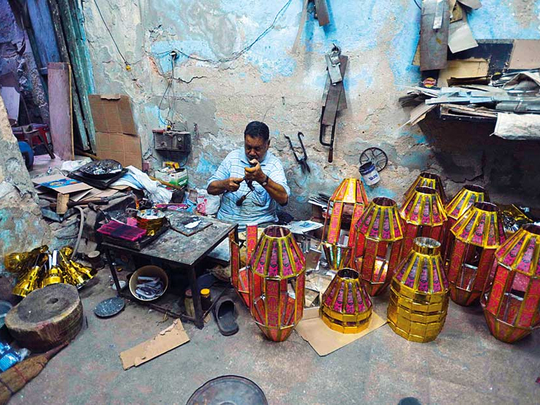
Cairo: Unlike most Egyptians, Farouq Fawzy, a manufacturer of traditional lanterns, is happy about a recent decision that depreciated the local pound.
“This decision has come as a kiss of life for our craft,” Fawzy, 56, said as he pieced together a lantern made of tin metal inside his workshop in an Islamic Cairo quarter.
Traditional Egyptian lanterns are always in high demand during Ramadan. |
Courtesy: Saeed Shehata |
Last November, Egypt free-floated its currency as part of tough economic reforms. The move has triggered rise in prices of different goods and services.
“The pound flotation has made prices of all imported items, including the Chinese lanterns, soar. As a result, traders have turned their attention to the local products and their manufacturers. At last, we’ve won,” Fawzy, a father of five, said with a grin.
The lanterns are a centuries-old feature of Ramadan in Egypt. Children and grown-ups are fond of them.
However, in recent years, local lanterns took a hard beating from the Chinese lanterns which flooded the Egyptian market.
“Now it’s the turn of the Chinese lantern to receive the knockout blow. This has happened this year for two reasons,” said Fawzy, who has been in the business for more than three decades.
“One reason is the pound flotation decision. The second is that Chinese lanterns have lost their attraction for Egyptians, who have realised the value of the local lanterns and its long history,” he told Gulf News.
The first candlelit lanterns had been used in Egypt on the seventh day of Ramadan in 362 AH (June 11, 972AD) when residents of Cairo took to the streets to welcome their new Fatimid ruler Al Mu’ath Al Deen Allah, some historians say.
From then on, the candlelit lanterns have become a feature of Ramadan celebrations. The lantern-making industry thrived under the Fatimids, who ruled Egypt for nearly two centuries.
Present-day Egyptian lantern makers such as Fawzy have improvised their products by replacing candles with the battery-powered lights.
“I have also added decorative stars and crescent in order to make the lantern attractive to the children as well as older people,” Fawzy said.
Since the currency devaluation, Fawzy said he has been flooded with orders from Egyptian merchantst to supply them the traditional lanterns for the peak Ramadan season.
“Because of this flood [of orders], I haven’t found time to paint the walls of my workshop," he added, pointing to the interior of his workshop dotted with yellow tin lanterns in the Islamic Cairo district of Bab Al Khaleq.
Until some months ago, Fawzy used to work alone because there was no big demand for his product.
“But the situation has been totally during past months. I have to hire several craftsmen and apprentices to meet the growing demand for the lanterns," he said, as he kissed his palm in a sign of satisfaction.
Traditionally, in the run-up to Ramadan, stores across Egypt display a variety of decorated lanterns to entice clients.
In addition to the lanterns made up of tin, this year’s popular line of the genre includes stained glass lamps, long associated with celebrating Ramadan in Egypt.
Other popular brands are the lanterns made of ornamental wood and those draped in a colourful tent fabric known as Al Khayamiya, according to traders.
“This year, the demand is high for the Egyptian lanterns because of their different shapes and sizes and the price compared to the Chinese lanterns,” said Mahmoud Al Shami, a store keeper in the Cairo working-class area of Al Matariya.
“Prices of the Chinese lanterns have doubled after the [pound] flotation while those of the Egyptian lanterns have increased by around 30 to 40 per cent compared to last year.”
For example, a medal-shaped traditional lantern sells for five Egyptian pounds (around Dh1), compared to three pounds last year, Al Shami told Gulf News.
Prices of the lantern made up of tin start from LE50 up to LE1, 500, depending on the size.
In Ramadan, hotels and coffee shops across Egypt decorate their Ramadan-themed tents with large ornamental lanterns.
In 2015, Egyptian authorities banned the import of foreign lanterns in an attempt to protect the local industry. The ban was part of a wider government effort to preserve Egypt’s traditional handicrafts.
The Chinese lanterns are usually shaped like toys, emitting flickering lights and playing Egyptian songs associated with Ramadan.
“The Chinese lanterns have lost their attraction because of the bright designs of the Egyptian lanterns,” said Al Shami.
“Whether children or adults, the joy of Ramadan is not complete without the lantern. The Egyptian lantern is the one that invokes the real spirit of Ramadan.”












